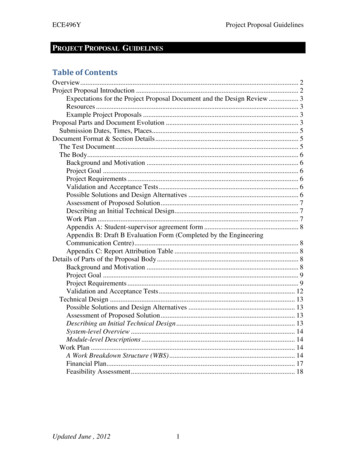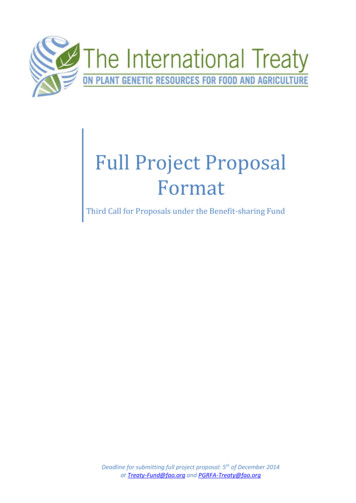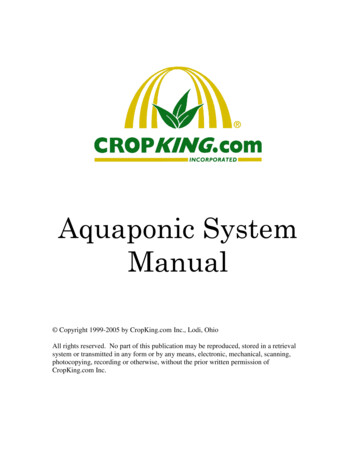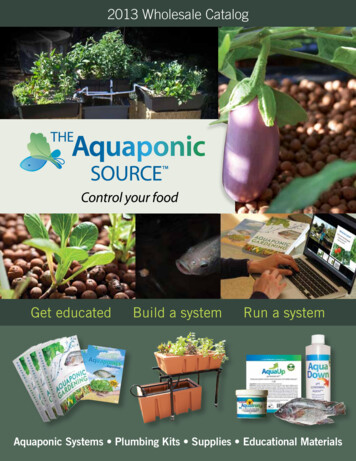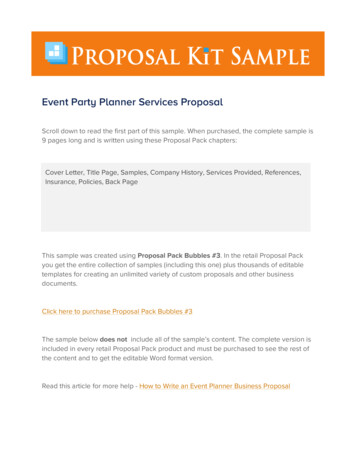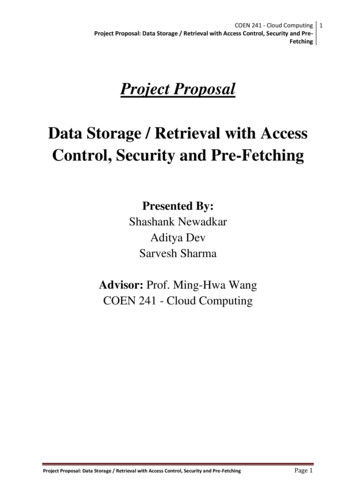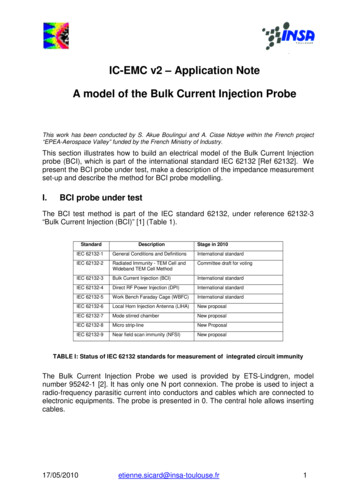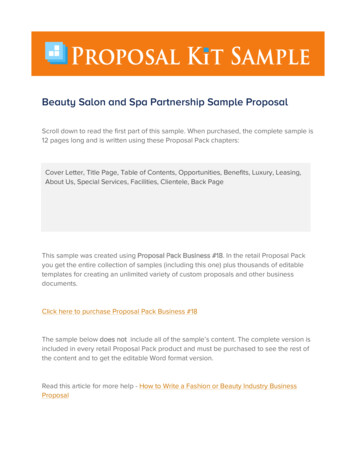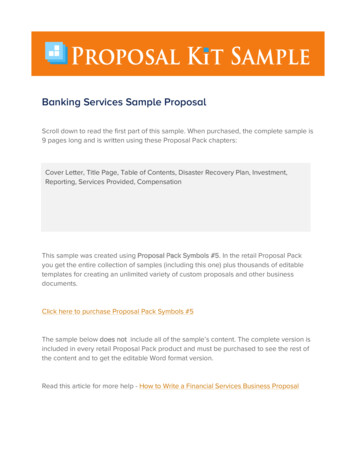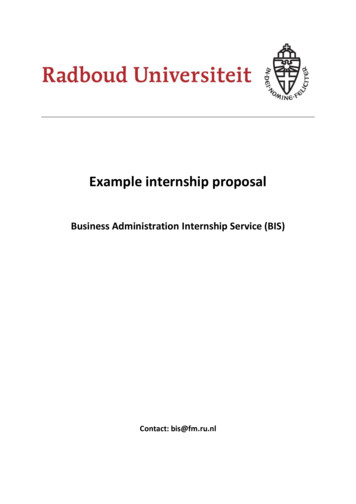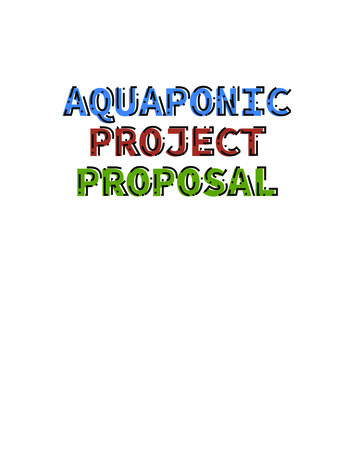
Transcription
AQUAPONICPROJECTPROPOSAL
L’ORTO DE LU SUD1Terra mara e nicchiaricavistuta de spine e de cramigna,e a ‘gne vvannacime curve e ssiccate.Fernando RausaAtuhor: Gianlorenzo De SantisPhotos and graphic design: Gianlorenzo De SantisIcons: freepik.com1. From: Fernando Rausa, Terra mara e nicchiarica. Manni Editori, 2016.
PROJECTDESCRIPTIONThe project proposed is an integrated,agricultural system that is composed by ahydroponic and aquaculture (aquaponics) recirculating cycle, and a separate insect rearingunit.AQUAPONICUNITAquaponics is the integration of hydroponic plantproduction with aquaculture, two of the mostinto a sustainable agricultural integrated and virtually closed system.wastes, which are a source of nutrient, to aid the production of the selected crops in thecreates a natural biological cycle that: 1) supplies nitrogen to the crops; 2)minimizes theuse of non-renewable resources; 3) maximizes the value of by-products, thus providing2006; Tyson, Treadwell, & Simonne, 2011)This integration has numerous advantages, that tackle key issues in the current, bothglobal and local, agricultural landscape, and it is deemed by multiple prestigious sources(FAO in primisSink, 2015; Somerville & FAO, 2015).WATER USEmain resource, the water.Water use is maximized, which means that itsto traditional agricultural and aquaculture systems.from 80 to 90% (Somerville & FAO, 2015).Furthermore, being a closed system, the inputrequirement is very low and it needs only toaccount, during standard operations, for the naturalevaporation and for the plant uptake (Mullins et al.,2015; Pattillo, 2017; Rakocy et al., 2003; Somerville &FAO, 2015).Water quality is, therefore, a vital aspect to monitorin such system and its parameters should be closelychecked and adjusted.
SOILLES GROWINGThe use of soilless agricultural solution has beenon the surge in the last few years. Many hydroponicsolutions are appearing day after day on the market.For example, this has been one of the main focus ofthe 2017 Seeds and Chips Global Innovation Summitheld in Milan and that witnessed the presence of the44th President of the United States, Barak Obama.Avoiding using soil for crop production has directpositive impact on the soil itself.An immediate consequence of this, is that the set-upof a RAS facility, in a relatively small area, does notrequire any preparation to the soil itself and it canbe performed in zones where the composition or thefertility of the soil (non-arable, urban areas, degraded,with high salinity or even deserts) does not allow fortraditional means of production (Georgia Pollard,James Ward, & Barbara Koth, 2017; Leoni, 2003;Somerville & FAO, 2015).Nutrients are not dispersed in the soil, which meansa better control and a better delivery rate of suchnutrients to the plant. It drastically reduces the riskof harmful contamination of the soil, groundwaterand the general environment. Furthermore, usingthis technique to produce crops, even in the case ofintensive monoculture, does not degrade the soil,depleting its substance composition: a process calledsoil erosion, which it has been in the last decades oneof the main environmental concern, especially in areaswith high agriculture intensity (Atasu, 2016; EuropeanCommission & Directorate-General for Agriculture andRural Development, 2006; Leoni, 2003; Somerville &FAO, 2015).IMPROVED PRODUCTIONAND YIELDProduction of crops and fishes is maximized, and thecost is contained.Fish yield is improved, thanks to the higher fish densityallowed by the recirculating water system, and due tothe controlled rearing production environment, thatcan be maintained all year round, with minimizedhealth risk (Bernstein, 2011; Pantanella, 2012;Timmons & Ebeling, 2007).Crop yield as well is increased up to 100%, withrespect to conventional horticulture (Resh, 2012)due to various factors(Bailey & Ferrarezi, 2017; Leoni,2003): Higher plant density, which is possible in soillesscultivation, thanks to lack of nutrient competitionbetween crops. Better environmental and climate control of thegrowing conditions, which also leads to a betterquality, more marketable, products. Shorter production cycles and higher number ofharvest per year. Less (near zero in optimal condition) impact ofexternal pathogens.These benefits lead to an overall better productionefficiency: for example, in the case of tomatoes 95% ofproduce reaching harvesting maturity, with respect tothe 75% of traditional techniques.
OPERATING COST ANDLABOUREven if an aquaponic systemrequires a constant monitoring,with relative adjustment tothe requirement of its variouscomponents (mainly water qualityand filter efficacy checks, fishfeeding), it is deemed to have verylight labour requirements.Furthermore, many of the maindaily operations required could beeasily, alongside a slightly higherinitial investment, automated anddigitalized. Especially regardingthe monitoring operation,resulting in significant labourintensity and time savings (Mason,2011; Somerville & FAO, 2015).ORGANIC BY DEFAULTBy its own intrinsic characteristicsan aquaponic system is inherentlyorganic by default and it easilymaintained so. Particularlyregarding the water PH, throughorganinc allowed substances(European Commission &Directorate-General for Agricultureand Rural Development, 2017).Makign it easy to obtain theorganic certification, which willimprove the final prodcut overallvalue and its market potential.GREENHOUSE ROUTEThere are various viable way toimplement such system, but oneof the most diffused (Love et al.,2014, 2015) is the enclosure of theentire plant into a greenhouse.This poses varius benefits. Itallows for example for a higherdegree of environmental controlallowing year-round growth atoptimum rates (Masser et al.,1999) increasing at the same timethe level of Biosecurity and lowerrisk from outer contaminants(Somerville & FAO, 2015).
REDUCING THE INPUTWater, energy, and fish feed are the three largest physical inputs for aquaponic systems (Love et al.,2014).As already mentioned, the water input, in optimalconditions, is minimal (one of the key benefit of suchsystems).As for the energy input, it is key for the survival ofthe entire system. it is required continuously for thecorrect function of the water and air pumps thatkeep the recirculating system flowing. This inputrequirements can increase if the system also usesadditional mean to control the growing environment:for example, growing lights and temperature andairflow system in greenhouses. However energyinput cost can be reduced, at the expense of a slightlyhigher initial investment, by employing alternative,sustainable, energy sources (solar, wind, biofuel,etc ). A more desirable choice because it helps tofurther reduce the carbon footprint and contributesto the overall added value of the final product(Bernstein, 2011; Pantanella, 2012; Pattillo, 2017;Somerville & FAO, 2015; Tyson et al., 2011).The last input required, therefore a component ofthe operating cost, is the fish feed. Feed is essentialbecause is the source of all the nutrients (principallynitrogen) used by the system, substituting moreexpensive commercial hydropponic nutrient solutions.It needs to be carefully quantified to fit the systemrequirements and it represents one of the mostexpensive input. Here is where the insect rearingcomponent of the project becomes relevant:“Insects are a healthy nutrient sourcebecause they are rich in protein andpolyunsaturated fatty acids and full ofessential minerals.”(Somerville & FAO, 2015)And they can be used to substitute or complementthe fish feed, drastically reducing this portion of theoperating cost. (Engle, 2015; Graber & Junge, 2009;Charlotte L.R. Payne, Scarborough, Rayner, & Nonaka,2016; Somerville & FAO, 2015)INITIAL INVESTMENTAfter listing the benefit of aquaponics, it is appropriatealso to mention that, plausibly, the major barriers tothe implementation of these systems: the first is thehigher initial set up cost, in confront to traditionalagricultural techniques; the other is the moderateenergy input required, which is alreadu been adressedin the previous section (Engle, 2015; Love et al., 2015;Pattillo, 2017; Rakocy et al., 2003).The initial investment is typically paid back in 3 to 4years (Nelson & Pade, 2010a, 2010b). There are variousmeans aimed to reduces and contain the cost of suchinvestment: for example, renting existing greenhouse(which is usually the most expensive component ofan aquaponics installation) could reduce the paybacktime up to just 1 year (portfarms, 2016); anotherpossible way is to design the system with a modularapproach (using the NFT1 method ) in mind, to be ableto more easily upscale at a later time (Georgia Pollardet al., 2017; Pattillo, 2017).1. Nutrient film technique. It consists of narrow plastic channels for plant support with a film ofnutrient solution flowing through them.(Rakocy, Masser, & Losordo, 2003)
REFERENCESAtasu, A. (Ed.). (2016). Environmentally Responsible Supply Chains(Vol. 3). Cham: Springer International Publishing. https://doi.org/10.1007/978-3-319-30094-8Bailey, D. S., & Ferrarezi, R. S. (2017). Valuation of vegetable cropsproduced in the UVI Commercial Aquaponic System. AquacultureReports, 7, 77–82. in, S. (2011). Aquaponic gardening: a step-by-step guide toraising vegetables and fish together. Gabriola Island, BC: NewSociety Publ.Engle, C. R. (2015). Economics of Aquaponics. SRAC Publication, 5006.European Commission. (2017). Report on the implementation of theCircular Economy Action Plan. Retrieved from mplementation report.pdfEuropean Commission, & Directorate-General for Agriculture and RuralDevelopment. (2006). The Leader approach: a basic guide. Luxembourg:EUR-OP.European Commission, & Directorate-General for Agriculture and RuralDevelopment. (2017). “BASIC SUBSTANCES” THAT MAY BE USED IN ORGANICAGRICULTURE IN ACCORDANCE TO ANNEX II OF COMMISSION REGULATION(EC) No 889/2008. Retrieved from farming/files/basic substances approved in organicagriculture.pdfEuropean Network for Rural Development. (2017). Green Economyopportunities for rural Europe - For, Europe - 2017.pdf. EU RURALREVIEW, (23).Georgia Pollard, James Ward, & Barbara Koth. (2017). Aquaponicsin Urban Agriculture: Social Acceptance and Urban FoodPlanning. Horticulturae, 3(2), 39. , A., & Junge, R. (2009). Aquaponic Systems: Nutrient recyclingfrom fish wastewater by vegetable production. Desalination, 246(1–3),147–156. https://doi.org/10.1016/j.desal.2008.03.048Leoni, S. (2003). Colture senza suolo in ambiente mediterraneo. Bologna:Edagricole.Love, D. C., Fry, J. P., Genello, L., Hill, E. S., Frederick, J. A.,Li, X., & Semmens, K. (2014). An international survey of aquaponicspractitioners. PloS One, 9(7), e102662.Love, D. C., Fry, J. P., Li, X., Hill, E. S., Genello, L., Semmens,K., & Thompson, R. E. (2015). Commercial aquaponics production andprofitability: Findings from an international survey. Aquaculture,435, 67–74. ason, J. (2011). Commercial hydroponics. Gold Coast: ACSDistance Education. Retrieved from https://www.overdrive.com/search?q BC5CB979-6D6E-42DE-8597-044B72B0433F
Masser, M. P., Rakocy, J., & Losordo, T. M. (1999). Recirculatingaquaculture tank production syste ms. SRAC Publication, 452.Matsumoto, M., Masui, K., Fukushige, S., & Kondoh, S. (Eds.). (2017).Sustainability Through Innovation in Product Life Cycle Design.Singapore: Springer Singapore. https://doi.org/10.1007/978-981-100471-1Mullins, C., Nerrie, B., & Sink, T. D. (2015). Principles of Small-ScaleAquaponics. SRAC Publication, 5007, 1– 8.Nelson & Pade. (2010a, 2017). Investment / ROI Nelson & Pade, Inc.Retrieved November 6, 2017, from tment-roi/Nelson & Pade. (2010b, 2017). What is the ROI on a commercial aquaponicsventure? Nelson & Pade, Inc. Retrieved November 6, 2017, n-a-commercialaquaponics-venture/Pantanella, E. (2012). Nutrition and quality of aquaponic systems (Phd).Univesità degli Studi della Tuscia, Viterbo.Pattillo, D. A. (2017). An Overview of Aquaponic Systems: HydroponicComponents.Payne, C. L. R., Scarborough, P., Rayner, M., & Nonaka, K. (2016). Asystematic review of nutrient composition data available for twelvecommercially available edible insects, and comparison with referencevalues. Trends in Food Science & Technology, 47, 69–77. s. (2016, December 10). Renting Greenhouses for 1 year Return onInvestment. Retrieved November 6, 2017, from cs/Rakocy, J. E., Masser, M. P., & Losordo, T. M. (2003). Aquaponics—Integrating Fish and Plant Culture. SRAC Publication, 454(16), 1–16.Rakocy, J. E., Masser, M. P., & Losordo, T. M. (2006). Recirculatingaquaculture tank production systems: aquaponics—integrating fish andplant culture. SRAC Publication, 454, 1–16.Resh, H. M. (2012). Hydroponic food production: a definitive guidebookfor the advanced home gardener and the commercial hydroponic grower.CRC Press.Somerville, C., & FAO. (2015). Small-scale aquaponic food production:integrated fish and plant farming. Food and Agriculture Organizationof the United Nations.Timmons, M. B., & Ebeling, J. M. (2007). Recirculating aquaculture.Tyson, R. V., Treadwell, D. D., & Simonne, E. H. (2011). Opportunitiesand challenges to sustainability in aquaponic systems.HortTechnology, 21(1), 6–13.van Huis, A. (2013). Edible insects: future prospects for food and feedsecurity. Rome: Food and Agriculture Organization of the UnitedNations.
INSECTREARINGUNITInsects have been identified as one of the few sustainablealternatives capable of feeding the planet in the future. And theiradoption in the “West World” is growing slowly, but steadily, with a sudden surge of interest in thelast few years, trend that is believed to endure (De Santis, 2016).Aquaculture, as a source of fish supply for human consumption, in the last 3 decades, increased itsshare compared to wild capture, fulfilling up to about 50% of the global fish demand (FAO, 2016;van Huis, 2017).To support this unprecedented growth there has been a corresponding rise in the demand,production, and price of fish meal. Fsih meal comes primarily from discarded fish stocks of wildcaught marine fish, which, is one of the leading reason behind the incumbent issue of overfishingand marine biodiversity erosion (Dossey, Morales-Ramos, & Rojas, 2016, Chapter 1; FAO, 2016; vanHuis, 2017, Chapter 1). Fish meal is used not only in aquaculture but also in many other traditionallivestock farming (Poultry and swine mainly). A lot of effort is beign put to find an alternative,more sustainable(both economically and environmentally), feed source that needs to be richin protein and lipids. And insects, in particular species like house flies, black soldier flies, andcrickets (Dossey et al., 2016; van Huis, 2017) have been identified as one of the most promising,sustainable, substitute or complement to fish meal and their viability as animal feed has beenevaluated in may studies. (Dossey et al., 2016; FAO, 2016; van Huis, 2017; van Huis, Dicke, & vanLoon, 2015).Their feasibility is especially a direct consequence of their high protein and lipid content whichis essential to the fish development and meat quality(Dossey et al., 2016; Surendra, Olivier,Tomberlin, Jha, & Khanal, 2016; van Huis, 2013a, 2013b, 2017).Next are explained some of the more significant benefits of using insects as a protein source: thefirst three, tightly connected to each other, have a more specifically environmental dimension,while the last three also are associated with compelling economic 40Source: Dossey et al. 20161. Liters per Gram of Protein2. Grams of Food Input per 1 g Body Mass6080100120
LAND USEAs mentioned before, a bettermanagement of the land andsoil’s resources, is a key factorin building a more sustainablefuture.“Food production takesup almost half of theplanet’s land surface andthreatens to consume thefertile land that stillremains”(Dossey et al., 2016)Insects can easily be reared incontrolled, indoor, environmentsthat make extremely efficientuse of the vertical dimension,increasing the productivity perm2 and avoiding the erosion andexhaustion of fertile soil.To yield, for example, an analoguequantity of protein produced in 1ha of land by mealworm rearing,milk protein would require 2.5 ha,chicken and pork around 2–3.5 ha,and beef requires up to 10 ha (vanHuis, 2013a).GAS EMISSIONREDUCTIONIn comparison to othersconventional livestock farming,insect rearing produces far lessammonia and greenhouse gases(Dossey et al., 2016; Payne,Scarborough, Rayner, & Nonaka,2016; van Huis, 2013a, 2017; Yen,2015).Estimates differ from speciesto species, but insects performoverall better regarding emissions.Ammonia levels, due to insectfarming, are lower than for pigsand beef cattle. For example,crickets (Acheta domesticus),which are associated with thehighest ammonia emission, stillproduce just around the 10% ofthe ammonia produced by pigs(calculated as mg of ammoniaper kg of mass gain) and anirrisory amount compared to beef,which produce 2 to 3 times morethan pigs. Crickets, moreover,along with migratory locusts(Locusta migratoria) and yellowmealworms (Tenebiro molitor)(which are currently three of themost reared species intended forfood and feed), do not producemethane (van Huis, 2017).WATER SAVINGThe water use, also, in comparisonto other livestock, is drasticallyreduced as insects obtain theirwater directly from food and havea lower feed requirements (Dosseyet al., 2016; Sogari, 2015; van Huis,2013a). When we consider thewater needs per gram of protein,this is smaller even compared toplants (Costa-Neto, 2014; Shelomi,2015; Soares & Forkes, 2014)Lower water usage also reducesthe energy needed to pump orrecycle more clean water for cropsand vertebrate livestock (Dosseyet al., 2016).
ORGANIC SIDE STREAMSFEED CONVERSIONEFFICIENCYSHORT CYCLESFrom a more economic point ofview, the main benefits of insectrearing are that their short lifecycles and their extreme efficiencyin transforming feed into proteinand nutrients (which is also, assaid, one of the reason for theirwater use efficiency (van Huis,2017)), which is particularlyimportant, as “an increaseddemand for meat will cause amore than proportional demandfor grain and high-protein feeds”(van Huis, 2013b).This short life cycle, which itcan also be further optimizedin a controlled environment,means an improved productivity,which, along with their generalinexpensiveness and relativeeasiness to rear, makes insect verycost effective to farm.Estimates show that crickets aretwice as efficient as chickens, 4times more efficient than pigsand 12 times more than cattle.Therefore insects can operate asvery efficient recyclers of organicwaste into biomass of highnutritional value (Surendra etal., 2016). This means that manyinsects species can be reared withalmost no additional feed cropproduction (Dossey et al., 2016).“The environmentalbenefits of rearinginsects for food andfeed are founded on thehigh feed conversionefficiency of insects.”(van Huis, 2013a)Using as a parameter the FeedConversion Efficiency, whichsimply is expressed as kg of massgain per kg of feed input, theevidence says that crickets requireonly 1.3–1.8 kg of feed for every1 kilogram of bodyweight gain.,while 12.7, 5.9, and 1.7–2.3 kg ofdry feed is needed fo beef cattle,pigs, and chickens, respectively,which means that they have anhigher efficiency than any of thecommon livestock: more thantwice higer than in chicks, 3 timeshigher than in pigs, 5 times higherthan in sheep, and nearly 6 timeshigher than in cattle. (Lundy andParrella, 2015).Similarly, protein conversionefficiency in house crickets is23–35% , compared to the 5, 13,and 25% in beef cattle, pigs, andchickens, respectively (Dosseyet al., 2016; Lundy & Parrella,2015; van Huis, 2013b). Thisdrastically reduce the amount ofthe feed input and, therefore, theproduction cost of high quantityand quality of this source ofproteins.One of the most important featureof insect rearing is the possibilityto use organic side-streams, whichcan help reduce environmentalcontamination and tackle theissue of food waste. Globally,one-third of all food produced iswasted, amounting to 1.3 billiontons per year. (van Huis, 2013a,2013b).Organic side streams are tehresult of bio-waste producedby agriculture, forestry, andhouseholds. Their use can aid inthe reduction of the already lowcosts and environmental impact,of large-scale insects rearing andcan create an alternate potentialincome for agri-businesses.(Nadeau, Nadeau, Franklin, &Dunkel, 2015)Black soldier fly (Hermeticaillucens), the common housefly(Musca domestica) and the yellowmealworm (Tenebrio molitor)are very efficient species at bioconverting organic waste, butother insect species, such ascrickets, can benefit as well fromthe substitution of feed with highquality organic side streams,like household and local marketvegetable leftovers, which canhelp to make their farming moreprofitable (van Huis, 2013a).
FUTURE DEMANDIn 2018 shall enter into force the EU regulation onNovel Foods (EU, 2015), thanks to which insects foodproducts, along with other food innovation (i.e. algaebased products), will be freely produced, sold andbought in all the EU states, with all the food safetyguaranties that the EU and the EFSA provide.In the last few years there has been an unrelentinggrowing interest in this field accompanied byincreasing investments: in America, millions of dollarshave been already raised by insect food and farmingcompanies (Klint Finley, 2016) and January (2017) theNetherlands-based insect farming enterprise Protix, ahas raised 45 million, which is the largest investmenton edible insects to date (Burwood-Taylor, 2017).Furthermore, such products are already present in themarket (Repubblica.it, 2017).CIRCULAR ECONOMYOne of the additional aim of the proposed integrated system is toadhere and take advantage from the growing global interest andcurrent shift toward the Circular Economy. A circular economypromotes sustainable development by stimulating reduction of wasteand enhancement of resource efficiency (Matsumoto, Masui, Fukushige,& Kondoh, 2017). Circular economy aims to ‘design out’ waste: Wastedoes not exist and products are designed and optimised for a cycleof disassembly and reuse.(MacArthur, 2013)The agricultural sector is under pressure to obtain higher yieldswith less input, implementing alternative designs aimed toward aviable and sustainable agriculture. Furthermore, insects can be usedas bio converter and they can grow on organic waste, following theCircular principles. (van Huis, 2013a)The EU is significantly involved into promoting this shift: underthe “Jobs, growth and investment” Priority, one of the three mainpolicy areas is the move “Towards a circular economy”, defined as:“helping European businesses and consumers make the transition toa stronger and more circular economy where resources are used ina more sustainable way”. (European Network for Rural Development,2017)In particular, “Key actions have been undertaken in areas such asfood waste, ecodesign, organic fertilisers, guarantees for consumergoods, and innovation and investments. Circular economy principleshave also been gradually integrated in industrial best practices,green public procurement, the use of cohesion policy funds, andthrough new initiatives in the construction and water sectors.”“Food waste is a key area in the circular economy and should beaddressed at many levels along the value chain. The Commission hasdelivered on a number of actions supporting the fight against foodwaste and the achievement of the related Sustainable DevelopmentGoal in this area. It launched a stakeholder’s platform on foodwaste prevention, made progress in developing an EU methodology tomeasure food waste, and prepared EU guidelines to facilitate fooddonations and the use former foodstuff as feed”(European Commission, 2017)
REFERENCESBurwood-Taylor, L. (2017, June 14). Protix Raises 50m in LargestInsect Farming Investment on Record. Retrieved November 10, 2017,from eto, E. M. (2014). Insects as human food: an overview. AmazônicaRevista de Antropologia, 5(3), 562–582.De Santis, G. (2016). Qualitative Research on the Attitudes towardConsumption of Insect Based Flours and Powders (Master Thesis).University College Cork, Cork, Ireland.Dossey, A. T., Morales-Ramos, J. A., & Rojas, M. G. (Eds.). (2016).Insects as sustainable food ingredients: production, processing andfood applications. London, United Kingdom ; San Diego, CA, UnitedStates: Elsevier/AP, Academic Press is an imprint of Elsevier.EU. (2015). Regulation (EU) 2015/2283 of the European Parliament and ofthe Council of 25 November 2015 on novel foods, amending Regulation(EU) No 1169/2011 of the European Parliament and of the Council andrepealing Regulation (EC) No 258/97 of the European Parliament andof the Council and Commission Regulation (EC) No 1852/2001. OfficialJournal of the European Union, 58(L 327), 28.European Commission. (2017). Report on the implementation of theCircular Economy Action Plan. Retrieved from mplementation report.pdfEuropean Network for Rural Development. (2017). Green Economyopportunities for rural Europe - For, Europe - 2017.pdf. EU RURALREVIEW, (23).FAO (Ed.). (2016). The state of world fisheries and aquaculture:Contributing to food security and nutrition for all. Rome.Klint Finley. (2016, July 3). You’ll Eat Bugs. These Investors AreBetting Millions on It. Retrieved November 10, 2017, from ns-wont-balk-eating-bugs/Lundy, M. E., & Parrella, M. P. (2015). Crickets Are Not a Free Lunch:Protein Capture from Scalable Organic Side-Streams via High-DensityPopulations of Acheta domesticus. PLOS ONE, 10(4), 785MacArthur, E. (2013). Towards the circular economy.Matsumoto, M., Masui, K., Fukushige, S., & Kondoh, S. (Eds.). (2017).Sustainability Through Innovation in Product Life Cycle Design.Singapore: Springer Singapore. https://doi.org/10.1007/978-981-100471-1Nadeau, L., Nadeau, I., Franklin, F., & Dunkel, F. (2015). The Potentialfor Entomophagy to Address Undernutrition. Ecology of Food andNutrition, 54(3), 200–208. https://doi.org/10.1080/03670244.2014.930032
Payne, C. L. R., Scarborough, P., Rayner, M., & Nonaka, K. (2016). Areedible insects more or less ‘healthy’ than commonly consumed meats?A comparison using two nutrient profiling models developed to combatover- and undernutrition. European Journal of Clinical Nutrition,70(3), 285–291. . (2017, August 14). Svizzera, insetti da mangiare inarrivo nei supermercati Coop. Retrieved November 10, 2017, s/svizzera insettida mangiare in arrivo nei supermercati coop-173049651/Shelomi, M. (2015). Why we still don’t eat insects: Assessingentomophagy promotion through a diffusion of innovations framework.Trends in Food Science & Technology, 45(2), 311–318. https://doi.org/10.1016/j.tifs.2015.06.008Soares, S., & Forkes, A. (2014). Insects Au Gratin - An Investigationinto the Experiences of Developing a 3D Printer that uses InsectProtein Based Flour as a Building Medium for the Production ofSustainable Food. In E. Bohemia, A. Eger, W. Eggink, A. Kovacevic,B. Parkinson, & W. Wits (Eds.), Design education & human technologyrelations: proceedings of the 16th International Conference onEngineering and Product Design Education, University of Twente,Enschede, The Netherlands, 4th-5th September 2014. Glasgow, UnitedKingdom: The Design Society.Sogari, G. (2015). Entomophagy and Italian consumers: an exploratoryanalysis. Progress in Nutrition, 17(4), 311–316.Surendra, K. C., Olivier, R., Tomberlin, J. K., Jha, R., & Khanal, S. K.(2016). Bioconversion of organic wastes into biodiesel and animalfeed via insect farming. Renewable Energy, 98, 197–202. https://doi.org/10.1016/j.renene.2016.03.022van Huis, A. (2013a). Edible insects: future prospects for food and feedsecurity. Rome: Food and Agriculture Organization of the UnitedNations.van Huis, A. (2013b). Potential of Insects as Food and Feed in AssuringFood Security. Annual Review of Entomology, 58(1), 563–583. van Huis, A. (Ed.). (2017). Insects as food and feed: from productionto consumption. The Netherlands: Wageningen Academic -0van Huis, A., Dicke, M., & van Loon, J. J. A. (2015). Insects to feedthe world.Yen, A. L. (2015). Foreword: Why a Journal of Insects as Food andFeed? Journal of Insects as Food and Feed, 1(1), 1–2. https://doi.org/10.3920/JIFF2015.x001
OPPORTUNITYFOR PUGLIAWATER MANAGEMENTSome of most known hypothesis regarding theetymological origin of “Apulia” state that the termoriginates from “without water” or “thirsty” land(darapri.it, 2017), which is reflected on the fact thatApulia is the Italian region with the lowest rainfallaverage value (i.e. about 660 mm)(Lopez & Vurro,2008).So even in the name itself water has always beenan issue for this territory, which is characterisedby an inherent lack of bodies of water, and alreadycategorized as a semi-arid; circumstance that staysparticularly critical because of its agriculturaldisposition: Puglia has most of agricultural relatedbusiness of any other Italian regio
The project proposed is an integrated, agricultural system that is composed by a hydroponic and aquaculture (aquap
